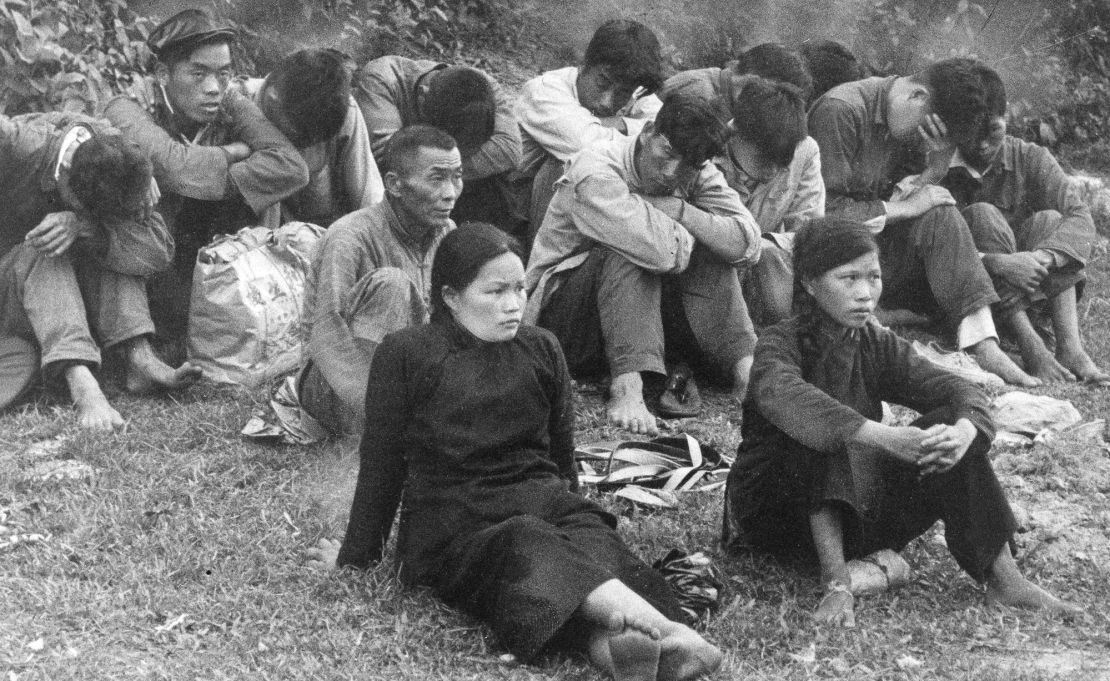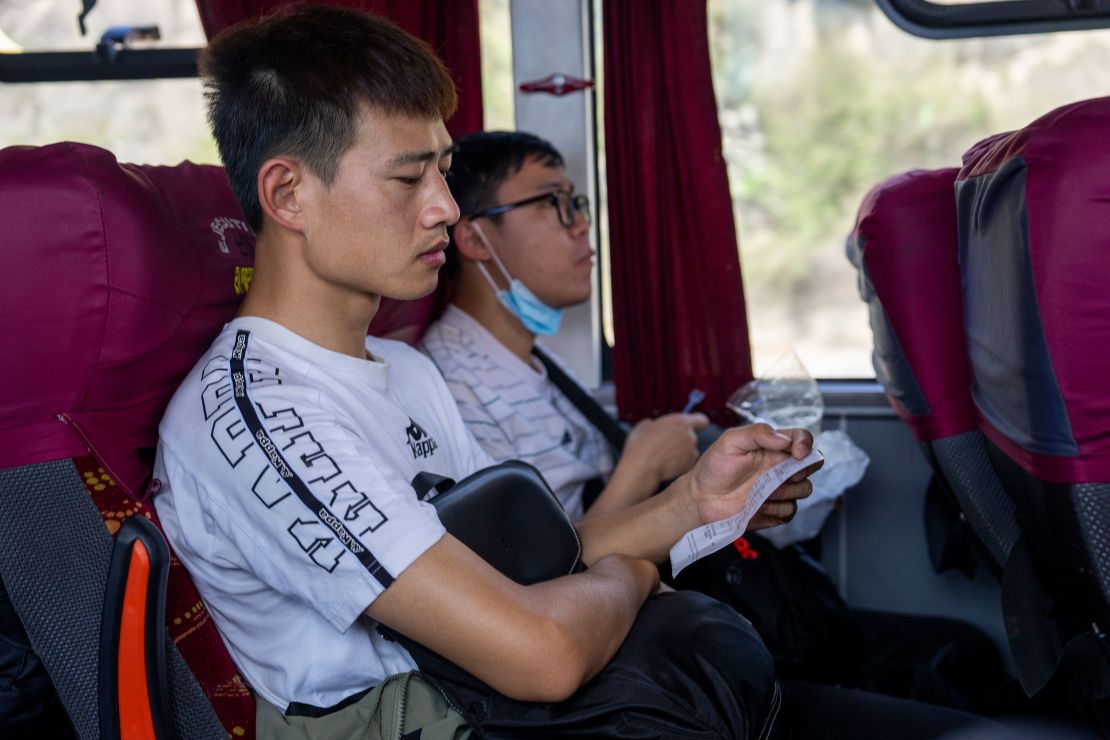They come with backpacks carrying a few spare changes of clothes and whatever money and phones they weren’t robbed of by criminals or cartels along the way, arriving at the United States-Mexico border exhausted from the stress of the journey north.
Like the hundreds of thousands of people around them who have also trekked weeks to reach the US, they’re driven by a desperation to escape and make a new life, despite the uncertainty of what’s on the other side.
But these migrants are fleeing the world’s second largest economy and an emerging superpower.
On a recent winter day, dozens of Chinese nationals waited in different makeshift camps scattered outside San Diego, California, just north of the Mexican border.
A group of Chinese migrants gathered at a temporary camp near the US-Mexican border after illegally crossing into the US.Evelio Contreras/CNN
Bundled in hoodies and jackets, they huddled around fires as they, and others there, counted the time before US border control agents would take them away for processing – and what they hoped would be the start to their lives in America.
These arrivals are part of a staggering new trend. In the first 11 months of 2023, more than 31,000 Chinese citizens were picked up by law enforcement crossing illegally into the US from Mexico, government data shows – compared with an average of roughly 1,500 per year over the preceding decade.
Their numbers are still dwarfed by those from regional neighbors like Mexico, Venezuela, and Guatemala, and they are not alone in coming from other parts of the world. But the influx of people from China making that crossing spotlights the urgency many now feel to leave their native country, even in the midst of what leader Xi Jinping has claimed is a “national rejuvenation.”
Many who left point to a struggle to survive.
Three years of Covid-19 lockdowns and restrictions left people across China out of work – and disillusioned with the ruling Communist Party’s increasingly tight grip on all aspects of life under Xi. Now, hope that business would fully rebound once restrictions ended a year ago has vanished, with China’s once envious economic growth stuttering.
Others nod to restrictions on personal life in China, where Xi has overseen a sweeping crackdown on free speech, civil society and religion in the country of 1.4 billion.
“We are Christians,” one neatly dressed middle-aged man said simply when asked what had led him there – a bare encampment thousands of miles from home.
These Chinese nationals join migrants from around the world whose numbers have overwhelmed the southwestern US border with illegal crossings in recent months. Most are seeking asylum after they cross – a pathway that may narrow in the coming weeks as Congress is expected to move to stem that flow amid a fierce debate over immigration.
For now, people from China are on track to be the fastest growing group making those crossings, according to a CNN analysis of the latest law enforcement data on border encounters.
And as the numbers making their escape have grown, so too has a network of businesses and social media accounts catering to Chinese migrants, who must often take a circuitous route across continents, before beginning the arduous, overland journey north.
The gateway
For many, that overland route begins in Quito, Ecuador – a city of roughly 2.5 million high in the Andean foothills that has become a gateway for those escaping China.
In 2022, Ecuador documented around 13,000 Chinese nationals entering. In the first 11 months of 2023, that number rose to more than 45,000. The country doesn’t require visas for Chinese passport holders.
A cottage industry of businesses caters to the border-bound, starting with airport pickups to arranging stays at Chinese-run hostels and organizing the journey north – often for a hefty fee, CNN reporting has found.
Evidence of the growing trend appears across Quito, if one knows where to look.
At one bus station, a ticket agent has a sign for “the Colombian border” printed in Chinese, ready to flash to potential customers. At a local hospital offering vaccinations – recommended for a treacherous jungle crossing – the Spanish-speaking nurse keeps a Chinese translation of the intake form on her desk.
A ticket agent in Quito holds up a sign written in Chinese for the bus to “Tulcan at the Colombian border.”Yong Xiong/CNN
Along the fringes of the city’s central business district are a growing number of businesses linked to the trend, travel agent Long Quanwei, who immigrated to Quito from China five years ago, told CNN last month.
There, convenience and department stores sell gear and goods needed for the trek north, while Chinese-run establishments offer housing, food and a place to link up with others headed north and decide about onward routes, Long says.
At one of these hostels, where a night’s stay with meals costs about $20, printed Chinese-language maps and instructions pasted to a wall detail each leg of the trip. The owner, who asked to remain anonymous for fear of online backlash, estimates there are 100 such small businesses like hers that cater to Chinese travelers, including those preparing to head north.
“Many people come here and don’t speak English or Spanish, so they look for me,” she said.
Among those passing through was Zheng Shiqing, who arrived in early December after first traveling by plane though Thailand, Morocco and Spain.
A slim 28-year-old with a serious expression, he had already met with setbacks.
On his first attempt to pass through Colombia, Zheng and a travel partner were robbed at gunpoint. With his phone and money gone, he turned back to Quito to regroup. Still, he remained determined that the only way is forward to the US – to break a cycle he sees in China.
“For ordinary people, survival is really difficult. It is really hard to live. Don’t even think about making money because you are being exploited by those (upper class) people,” Zheng said from the hostel as he prepared to set off for Colombia a second time with borrowed cash.
Zheng, a high-school graduate from rural Yunnan province whose parents are migrant workers in China, recounted how life had become increasingly difficult for people like him, despite decades of rapid economic growth lifting large parts of the population out of poverty.
He started factory work mixing glue for shoe boxes in his late teens, and later switched between jobs, including at an assembly line making smartphone parts for Apple. During the pandemic, he was locked down in another factory fabricating internet routers, unable to leave. After the lockdown ended, Zheng switched to another job, where he says his wages were never paid, even after he filed a formal complaint.
“There is no way out … unless your parents are officials or businesspeople. But if you are from the lower-class, even if you get married and have children, you will still follow the old path … it’s painful just thinking about it,” he said. “I wish I was never born … living feels so exhausting.”
Earlier this year, like thousands of other Chinese, Zheng decided to try “zou xian” or taking the “walking route” to America.
The phrase has become a euphemism for the perilous journey, as has “global travels” – one of the search terms people can key in to find online tutorials in Chinese for how to prepare, what to do at each leg and even what to say to immigration officials.
‘Dire straits’
China’s Covid-19 controls, relaxed only a year ago, hit blue collar workers in cities and residents in rural areas hard.
And now the economy continues to struggle under a property market crisis, high local government debt and the effects of a government crack-down on the once-booming private sector, all of which has cost jobs.
After urban youth unemployment hit record levels last year, the government stopped publishing data for the metric altogether. The Communist Party pledged to do more to bolster the economy — and quash bad news about it.
“It’s striking that so many are making this perilous journey to South America and up to the US when politically the country is very stable,” said Victor Shih, director of the 21st Century China Center at the University of California San Diego, pointing to a contrast with periods of emigration from China amid political turmoil.
“It suggests that a significant segment of the population is in economic dire straits.”
Hundreds of thousands fled the mainland for Hong Kong in the mid-20th Century amid civil war and, later, political turmoil and famine under the policies of Communist China’s founder Mao Zedong.
People escaping famine in mainland China were detained by Hong Kong police and British troops after crossing the border into the city in May 1962.AP
Chinese emigration to the US took off after the opening of China’s economy in the early 1980s, a little more than a decade after restrictive US immigration policies were dropped. Then, the number of people from China gaining permanent residency – a pathway often linked to family ties, employment, and political asylum – started to climb significantly, US data shows.
As China’s economy boomed in the early 2000s, dynamics shifted: there were more opportunity for workers there, while wealthier Chinese had greater resources to immigrate or study in the US.
But the country has also seen an intensified crackdown on civil society – and any form of dissent – during the past decade under Xi, its most authoritarian leader in decades.
In that period, China also has increased its control over religion and has been accused by the United Nations’ highest human rights body of perpetuating serious abuses that could amount to crimes against humanity for the way it treats Muslim minorities, a charge Beijing denies.
UN data shows the number of people from China seeking political asylum in the US and elsewhere around the world has sharply risen during Xi’s rule – climbing from nearly 25,000 in 2013 to more than 120,000 globally in the first six months of 2023.
Those who cross at the southern US border, who include not just single adults but families, are also typically seeking asylum, an immigration category for people escaping persecution. Previously, asylum seekers from China might apply after entering the US on a tourist visa, or via a different route that may not involve being detained at a border, immigration experts say.
Now, the southern border has emerged as a better-known route amid a broader increase in the number of people from around the world crossing there since the pandemic ended.
Those who’ve entered illegally on that route must typically pass an initial screening in order to stay in the US and apply for asylum, though different migrants may face different circumstances amid an overwhelmed system.
Congress is expected to act to update immigration rules for the border in the coming days, which could change and narrow existing rules, experts say.
Within the overall increase in such crossings, the rising number of Chinese nationals who are willing to take the treacherous route – even at a time of sharp political tensions between the US and China – appears as a new and telling trend.
Beijing has condemned the border crossings, with its Foreign Ministry telling CNN in a statement that it “opposes and resolutely cracks down on any form of illegal immigration activities, and is willing to actively engage in international cooperation on this matter.”
The ‘walking route’
For people like Zheng, even beginning the journey comes with a high price.
Those who rely on gathering information themselves and making their own way up through South and Central America, will spend at least $5,000 – more than a third of a Chinese factory worker’s average annual salary.
That includes flights out of Asia, typically through Chinese passport-friendly countries like Turkey, into Ecuador, and then cash for overnight stays, buses, taxis, boat rides, and, typically, a guide for crossing the notoriously dense jungle of the Darien Gap connecting Colombia with Panama – through which no roads run.
Those with means, however, can find ways to avoid some of the dangers. CNN uncovered information on an assortment of travel options and packages marketed to those from China looking to make the journey.
For $9,000 to $12,000, travelers can pay smugglers to arrange transportation for parts of the journey north, as well as a boat and guide for the optional rainforest crossing, all inclusive.
For those able to spend more, at least $20,000, the route gets easier: for example, help with a multiple-entry visa to Japan, which unlocks visa-free entry to Mexico, and transport to the border.
It’s not clear how many are taking those curated routes, but the offerings suggest a range of economic backgrounds among the border-bound. CNN compiled the information on these options by speaking with smugglers and others familiar with the industry, as well as from information in online tutorials.
Those from China who travel overland typically take what’s become a well-worn route from Quito to Tulcan, a small city perched on the border with Colombia.
There, residents told CNN they see hundreds – if not thousands – of Chinese migrants passing from Ecuador to Colombia each week.
The locals in Tulcan are adapting to the new group. One storekeeper whose snack shop sits on the way to the border charges a fee to help Chinese passing through set up an app for obtaining transit visas, allowing them to stay legally in Colombia for 10 days.
But she warns the crossing is dangerous: Chinese migrants are now prime targets for cartels and criminals, she says – something Zheng learned the hard way.
He passed through Tulcan a second time in mid-December and from there continued northeast to the coastal city of Necocli, where boats await to carry migrants across the Gulf of Urabá to the edge of the Darien Gap, which they then must traverse on foot.
Zheng Shiqing takes a bus from Quito to Tulcan on Ecuador’s Colombian border.Evelio Contreras/CNN
Images shared with CNN by Zheng and others from China show the perils of that miles-long jungle stretch. There, guided groups typically travel through dense rainforest and along rocky riverbanks, at times clambering over steep, slippery stretches – or gripping ropes to cross swiftly moving or deep river water.
In the final leg, clad in orange life jackets and seated in wooden boats, they follow a winding river to the next destination – temporary migrant camps in Panama, where they register, have a free meal and rest.
In Panama, authorities have resorted to busing people from these southern border camps to their northern ones – all in the dark of night, a Panamanian official told CNN. Then it’s on through Costa Rica, Nicaragua, Honduras, Guatemala and Mexico – if they’re not stopped by police or thieves.
For some, the final stretch into America is the most arduous.
A mother, Chen, 38, has spent at least two nights on the streets of Mexican towns with her two children, 15 and 11, as they struggle to make it to the border.
They aim to join her husband, who made the journey to the US a year ago following what she describes as detention and abuse from authorities in China because he was vocal about politics and attended church. She didn’t want to use her full name for safety reasons.
“Without knowing this path (to America), no matter how hard you’re pushed in life, you would only lie low in another city in China and just get by,” she told CNN from Tapachula, a town at Mexico’s southern border, as she calculated whether to pay a smuggler or try and bribe their way forward to get past immigration police.
Zheng faced similar struggles.
“In the rainforest, as long as I had the willpower, I could make it through. But Mexico, that’s a different story,” he told CNN in late December as he too stayed in Tapachula, trying to plan – and get funds for — his next move forward.
“(Here) there’s the risk of being deported, not to mention gangs and robbers. We can’t afford to take those risks … one more robbery and I’ll be ruined,” he said.
But, he added: “I will have to find a way. I’ve come this far. There’s no turning back now.”
American dream?
Days later, after scrounging together thousands more dollars to pay a smuggler to arrange a flight for him, Zheng made it to Tijuana just south of the California border.
After a brief detention there, he slipped through a gap in the border wall – finally reaching America.
There, like others who make that crossing, he waited in the country’s southernmost hinterlands in an informal camp. As he tried to stay warm, he kept thinking about what was next: “I need to find a job and live,” he told CNN by text before being taken onto a government bus for processing at a detention center.
For Zheng and thousands of others making the same crossing, this is where a new kind of uncertainty begins.
Those who are allowed to stay and enter an asylum claim after being processed by immigration officials may wait years to make their case in front of a judge within an overwhelmed system.
In the meantime, they can apply to work legally and move within the country, sometimes while carrying a government-mandated GPS tracker.
For Wang Qun, 34, whose journey to cross the border in June 2022 was documented by CNN, that waiting period has given him time to start his long-desired life in America.
Last fall, after months of memorizing English words for different parts of tractor trailers and their functions, Wang passed a licensing test. That’s allowed him to fulfill a goal he had back in his home country – becoming a truck driver in America.
Wang Qun, who immigrated to the US in 2022, has gotten a job as a truck driver.Evelio Contreras/CNN
Now, Wang is earning a decent living driving long hauls between California and Florida. He’s also expecting a baby with his partner, Iris, whom he met in Los Angeles after she made her own journey from China over the border just months after he did.
“I believe (Iris and I) are valuable to America. Because we are constantly working hard, paying taxes, I think our coming does not burden the US government,” he said. Wang declined to share the details of his asylum claim with CNN, as the case is pending.
But getting a positive ruling on such cases from the US government is far from a sure shot for applicants, regardless of their backgrounds, immigration experts say.
Chinese nationals have long been one of the largest groups of successful asylum seekers in the US, with nearly 13% of people granted asylum in 2022 coming from China, according to data from the Department of Homeland Security. That equated to just over 4,500 people approved that year.
Because wait times can be years long, the data doesn’t reflect the flow of people seeking asylum in 2022.
Those who choose that difficult path over the southern border now may come from different walks of life, but see their “livelihood and various interests being violated” in China, according to Ma Ju, a Chinese-Muslim community leader who won asylum in the US in 2019.
He would know – he’s running a shelter in New York City for new arrivals from China, largely those who say they are fleeing political or religious oppression. For many, it takes more than a year for a work permit in the US, he says, leaving them stuck in under-the-table jobs without labor protections as they wait to learn if they can stay.
But within the wait, there’s hope.
“Regardless of whether they’re here for economic reasons or other things, it’s for dignity – something they’ve never had in their home country,” Ma said.
CNN






